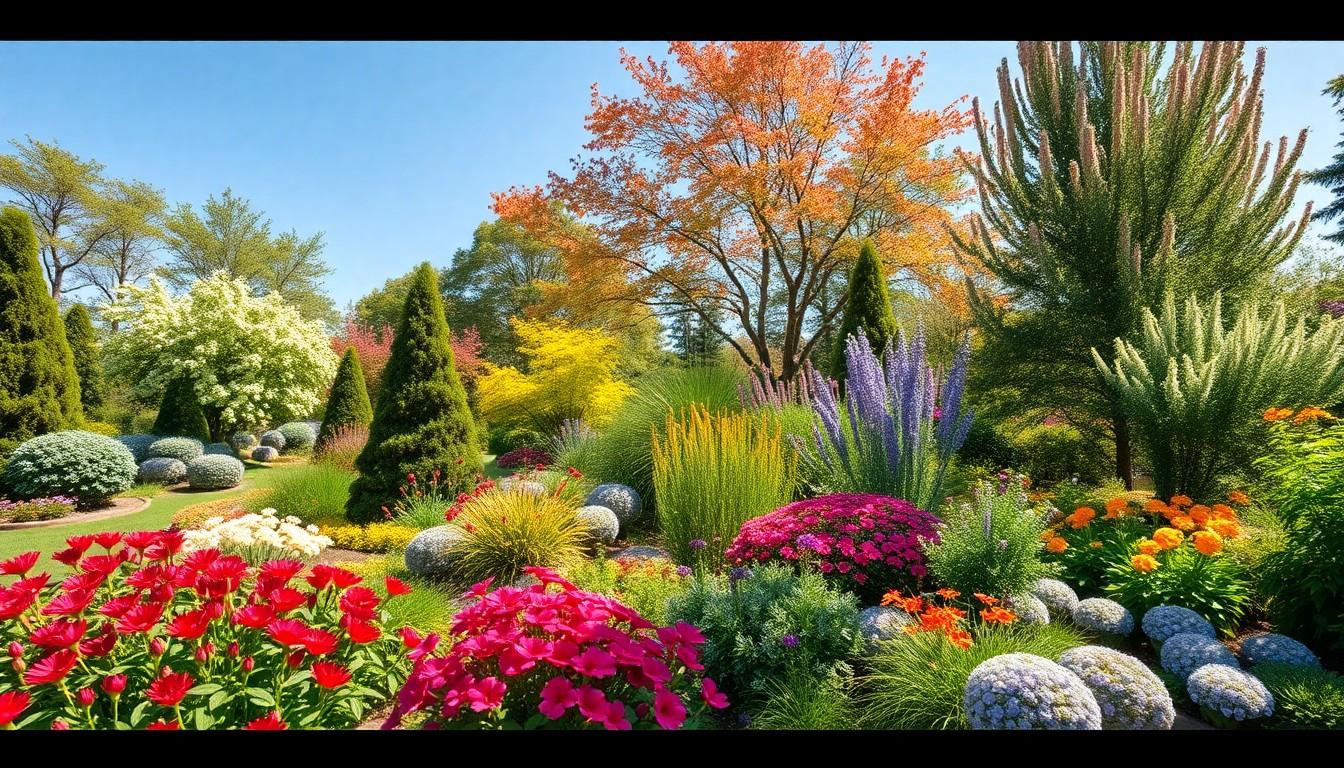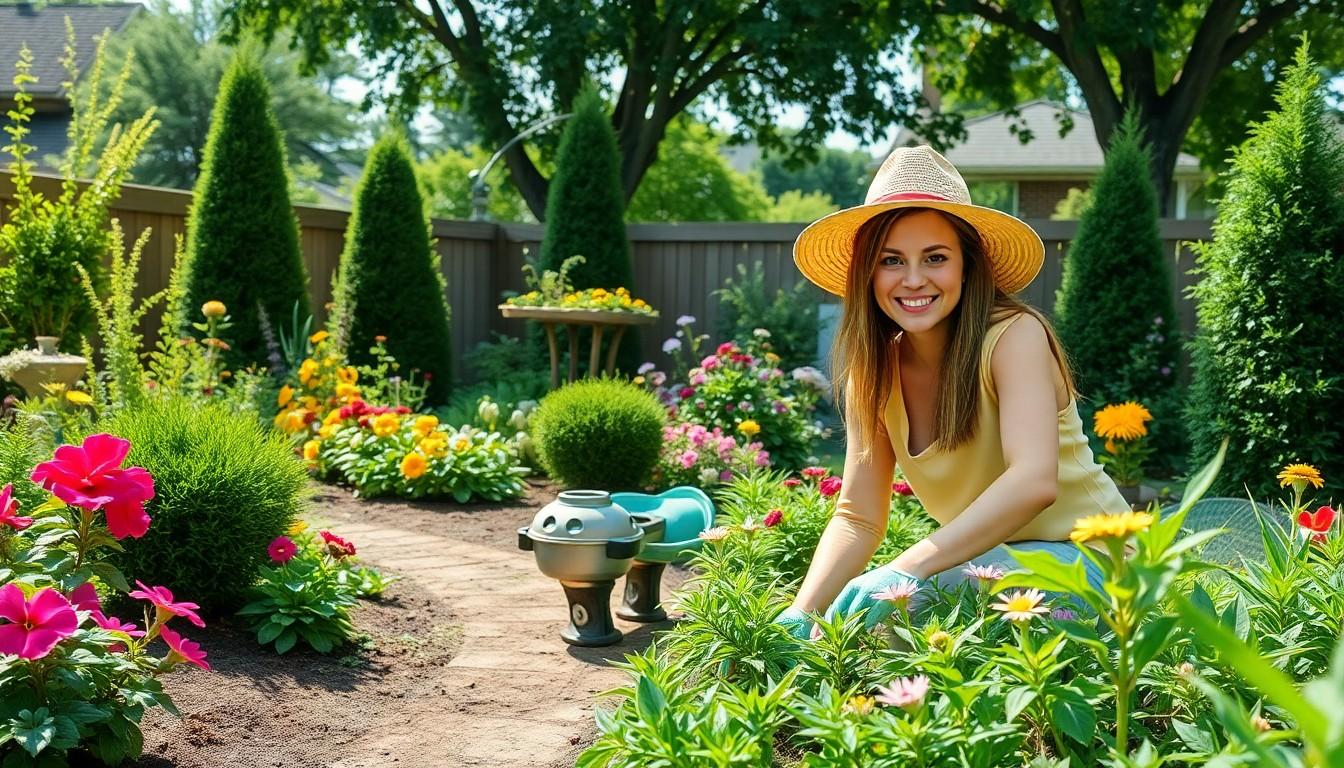Transforming a dull yard into a vibrant oasis doesn’t have to feel like an episode of a gardening reality show gone wrong. With the right plants for landscaping, anyone can create a stunning outdoor space that’ll have neighbors peeking over the fence in envy. Whether it’s creating a cozy nook for morning coffee or a lively area for weekend barbecues, the right greenery can make all the difference.
Overview of Plants for Landscaping
Choosing plants for landscaping involves understanding various factors, including climate, soil type, and design preferences. Different plants serve specific purposes, from providing color and texture to creating privacy.
Trees contribute height and shade to a landscape. They are essential for framing properties or creating focal points. Shrubs offer versatility, functioning well as borders or hedges. A variety of sizes and shapes allows for unique designs.
Flowers add vibrant colors and can attract pollinators. Perennials, such as coneflowers and daylilies, bloom year after year, making them a low-maintenance choice. Annuals like petunias or marigolds provide seasonal splashes of color, perfect for revitalizing a garden.
Ground covers play a vital role in preventing soil erosion. Plants like lilyturf or creeping thyme enhance visual appeal while improving soil structure. They require minimal upkeep and fill in empty spaces effectively.
In addition, ornamental grasses offer movement and texture. Varieties like fountain grass or blue fescue bring an elegant touch with their graceful forms.
Selecting native plants encourages sustainability. These species thrive in local climates and require less water and fertilizer, supporting the environment. Additionally, using native plants helps maintain regional biodiversity.
Lastly, considering the layout is key to successful landscaping. Grouping plants with similar needs reduces maintenance effort and fosters healthier growth. Planning a cohesive design creates a balanced atmosphere that enhances any outdoor space.
Types of Plants for Landscaping

Selecting the right types of plants greatly enhances the overall appeal and functionality of any outdoor space. Various categories of plants serve different purposes within a landscape design.
Trees
Trees provide essential height and shade. Options like oaks and maples thrive in diverse climates, offering stunning fall colors. They create a natural canopy, which helps cool the surrounding area. Additionally, flowering trees such as cherry and dogwood add seasonal beauty. Various evergreen species offer year-round greenery and privacy. When selecting trees, consider their mature size and root systems, ensuring they fit within the landscape.
Shrubs
Shrubs act as versatile foundation plants in any garden. Varieties include boxwoods for formal hedges and hydrangeas for vibrant blooms. These plants can fill spaces between larger plants or serve as borders. They can also provide privacy when planted strategically. Evergreen shrubs maintain their foliage year-round, while deciduous types showcase seasonal color changes. It’s crucial to match shrubs with the local climate conditions and soil types for optimal growth.
Perennials
Perennials offer a low-maintenance solution that blooms year after year. Popular choices like lavender and coneflower enhance gardens with color and fragrance. These resilient plants thrive with minimal care, making them perfect for busy homeowners. Selecting a mix of perennials ensures continuous blooms throughout the growing season. Their extensive root systems also help prevent soil erosion. Focus on soil quality and watering needs for ideal placement in the garden.
Annuals
Annuals add vibrant seasonal color to gardens and landscapes. Options such as petunias and marigolds bloom continuously throughout the growing season. These plants require replanting each year, offering a chance for fresh designs. They fill gaps left by perennials, providing visual interest and variety. Annuals can also attract pollinators, enhancing the ecological health of the yard. Placing them strategically can create stunning focal points in flower beds or containers.
Factors to Consider When Choosing Plants
Selecting the right plants for landscaping involves several crucial factors. Understanding these elements enhances garden health and aesthetics.
Climate and Hardiness Zones
Climate heavily influences plant selection. Hardiness zones indicate which plants thrive in specific temperature ranges. USDA hardiness zones classify regions based on minimum winter temperatures. For instance, Zone 5 accommodates plants hardy to -10°F (-23°C), while Zone 9 supports those that withstand 20°F (-6°C). Choosing plants suited to local climate conditions ensures better growth and resilience. Utilizing resources like local extension services provides guidance on zone-appropriate options.
Soil Type and Drainage
Soil characteristics determine plant health and vitality. Clay, sandy, and loamy soils each have unique drainage and nutrient retention properties. For example, clay retains moisture but may present drainage issues, while sandy soil drains well but requires frequent watering. Understanding soil composition helps in selecting plants that thrive in specific conditions. Conducting a soil test allows for informed improvements, such as adding organic matter to enhance fertility and drainage.
Sunlight Requirements
Sunlight availability significantly influences plant choices. Various plants have distinct light preferences, such as full sun, partial shade, or full shade. Full sun plants, like succulents and most vegetables, require at least six hours of direct sunlight daily. In contrast, shade-loving plants, such as ferns, flourish with minimal sunlight exposure. Assessing light conditions in the landscape helps in creating a garden that meets the specific needs of each plant variety. Positioning plants based on sunlight requirements maximizes their potential and contributes to a vibrant outdoor space.
Benefits of Using Native Plants
Native plants offer numerous advantages for landscaping. They thrive in local conditions, requiring less water and fewer resources to establish strong root systems. Their natural resilience enables them to withstand pests and diseases better, minimizing the need for chemical treatments.
Biodiversity increases with the inclusion of native plants. They attract local pollinators like butterflies, bees, and birds, enhancing the ecosystem’s overall health. This diversity supports a balanced environment, leading to stronger food webs.
Maintenance tasks decrease with native plant choices. Once established, these plants often require minimal upkeep, making them ideal for busy homeowners. Additionally, they adapt to seasonal climate changes, reducing the likelihood of plant stress.
Soil health benefits from native plants as well. Their root systems improve soil structure, promoting better water infiltration and reducing erosion. This nutrient enhancement contributes to a healthier landscape over time.
Cost-effectiveness stands out as another significant benefit. Less water, fewer fertilizers, and reduced pest control expenses lead to long-term savings. These financial advantages make native landscaping appealing for both residential and commercial spaces.
Aesthetic value enhances outdoor spaces. Native plants offer unique colors, textures, and forms tailored to local landscapes, creating visually appealing gardens. This natural beauty allows for cohesive designs that fit seamlessly into the surrounding environment.
Choosing native plants fosters a sense of place. Homeowners can create landscapes that reflect regional characteristics, promoting local heritage and pride. This conscious selection supports sustainability and community identity.
Maintenance Tips for Landscape Plants
Regular maintenance of landscape plants ensures thriving growth and beauty. Watering deeply and consistently encourages root development. During dry spells, plants may require additional watering, especially in their first year.
Mulch application around the base of plants helps retain soil moisture and suppress weeds. Organic mulch, such as wood chips or shredded leaves, improves soil health as it breaks down, while also enhancing the garden’s appearance.
Fertilizing landscape plants periodically supports healthy growth. Slow-release fertilizers are ideal for providing nutrients over time and reducing the risk of fertilizer burns. Specific plants may require tailored nutrient mixes based on their needs.
Pruning encourages healthy growth and enhances the shape of shrubs and trees. Timing varies; for example, spring-flowering shrubs should be pruned right after flowering. Regular deadheading of annuals and perennials promotes continuous blooming throughout the season.
Pest and disease management requires regular monitoring of plants. Identifying symptoms early leads to effective treatments, which could be mechanical, biological, or chemical methods. Utilizing integrated pest management strategies fosters a healthier ecosystem.
Weed control is essential for maintaining the health of landscape plants. Hand-pulling or using mulch effectively reduces competition for nutrients and water. Consistent monitoring commands attention to emerging weeds, ensuring they don’t overtake garden spaces.
Seasonal preparation protects plants during harsh weather conditions. Covering vulnerable plants or applying protective wraps prevents damage from frost and extreme temperatures. This proactive approach safeguards investments in landscaping.
Understanding specific plant requirements fosters success in landscape maintenance. Each type may have unique needs related to sunlight, soil, and water. Keeping a detailed schedule for maintenance activities promotes an inviting and thriving outdoor space.
Conclusion
Transforming a yard into a stunning landscape is achievable with the right plant choices. By considering factors like climate soil type and sunlight availability homeowners can create a thriving garden that serves as a personal retreat.
Incorporating a mix of trees shrubs perennials and native plants not only enhances aesthetic appeal but also promotes sustainability. With proper maintenance techniques such as deep watering and mulching the landscape will flourish year after year.
Ultimately a well-planned garden becomes a source of pride and enjoyment offering a beautiful space for relaxation and gatherings. Embracing the art of landscaping can truly elevate any outdoor environment.

